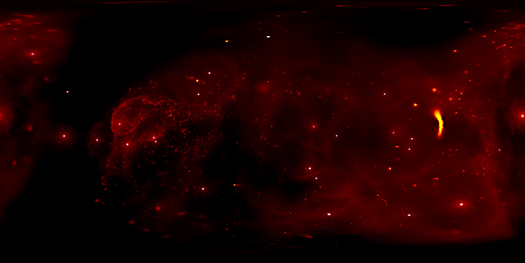A Scuba Dive, a (Failed) Ziploc Bag, and a Trip to the Center of the Galaxy

Chris Russell
We welcome this guest post from Christopher Russell of the Pontifical Catholic University in Chile. Dr. Russell was the creator of the new immersive movies that allow viewers to explore the center of the Milky Way in 360 degrees. In this post, Dr. Russell provides the backstory of how he came to make these innovative movies.
I went to a Galactic Center meeting in Australia in July 2016, where I saw an Occulus Rift (a high-end virtual reality, or VR, setup) display by Chi-Kwan Chan (Univ. of Arizona). With the Rift, you plug it into your computer (so much more powerful rendering than available with a phone) and your position actually determines what is rendered. So if you walk left, right, forward, or backward, you are actually walking through the simulation and therefore seeing a different perspective. The thought of visualizing one of these Galactic Center simulations in this fashion was immediately apparent. Then we talked about 360/VR videos; what is required from the goggle side, computer specs, rendering programs, etc.
The day after the meeting, I went snorkeling, and unfortunately the Ziploc bag I put my phone in to keep it waterproof failed. Not one of my brightest ideas, I must say. But when I was looking for a new phone, the one I wanted (Galaxy s7) had two available promotions: get a free 256 GB memory card (useful, but not really fun), or the Samsung Gear VR goggles (definitely fun). I chose the latter, so now I could at least view 360-degree videos in their native format, and so would be able to view one of the Galactic Center if I could figure out how to make it.
After much internet searching about how to make 360-degree videos, I figured out what format I needed to make my images in order to turn them into 360-degree movies, and then modified the graphics software I use for everything else with these simulations to do that. Once I made the first one and it looked really cool, I just kept trying to add elements to make them better.
So had I not had the bright idea to use a Ziploc bag to keep my phone dry in saltwater, we might not be here today.
Now to the scientific purpose of these. When I made the first one(s), I originally wanted to just see what the simulation would look like in this 360-degree format. There was no scientific test we wanted to do right away; the motivation was purely for visualization purposes, with the idea that the colliding stellar winds would be the most visually appealing part. Once I made the movie, though, I realized that it was the inspiraling/accreting blobs that are the most visually striking feature. In particular, I had never seen these blobs tidally stretch as they get closer to the Milky Way’s supermassive black hole, but it is readily apparent (if you look at the correct spot) in this video.
In the future, I hope to actually get a scientific result from these videos, though I imagine I'll have to change the quantity rendered. For example, I could make the color scheme be the angular momentum of the blobs, or the blob density that should decrease if the blob is tidally stretched. But that will have to be for the future.

